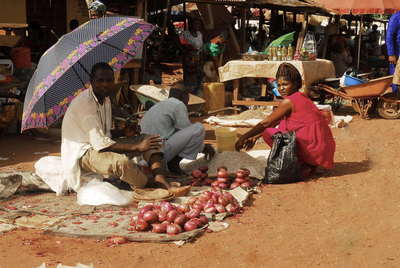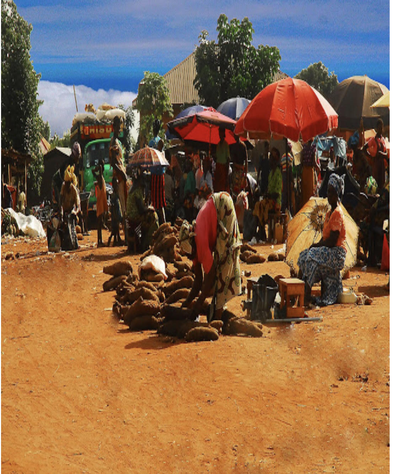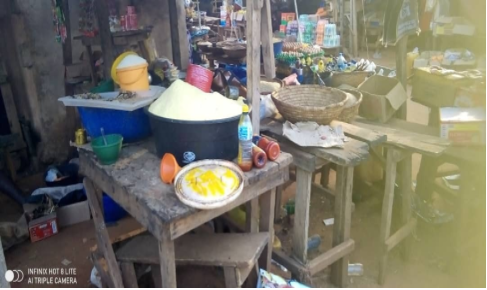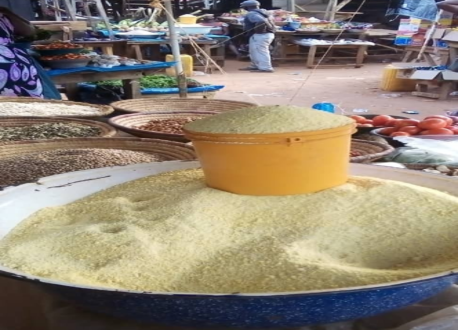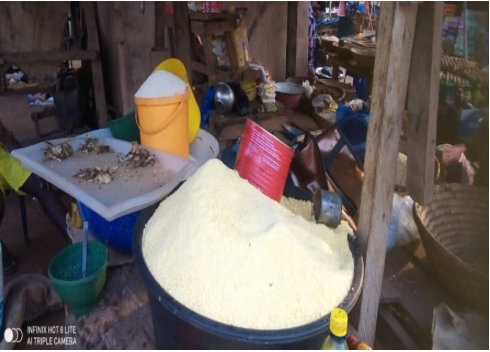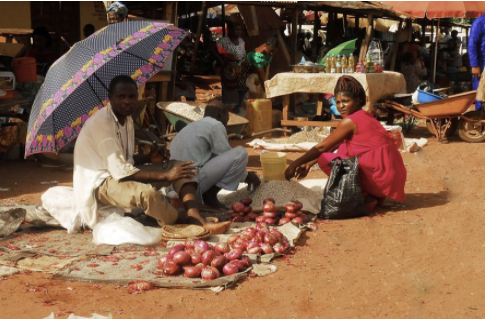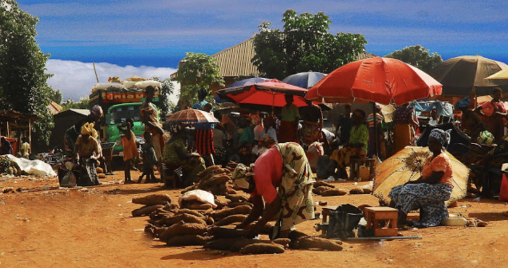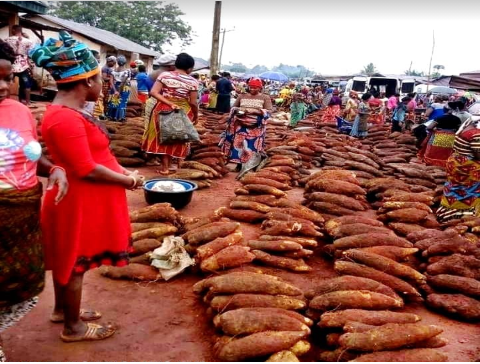Market days
The silent trade
In the olden days, this type of trade was practiced. This primitive merchandising method was done often in front of houses with large and extended compound, or at a section of the main street that is broad and prepared for gathering. Items like soap ingredients, coconuts, pepper, groundnut etc. are displayed in open air for sale. Items were bartered for other items or exchanged for cowries (Cowries, were the main currency and the smallest denomination of money in those days). Often, the actual owner of some items for sale may be absent; either somewhere far or working in the family farm. She comes back in the evening to collect her money for the item(s) sold, along with the unsold items. She places a piece of IDIGUN (god of Iron) in the center of the container and goes away knowing the respect for this juju would produce the same result as if she was sitting there to ensure that there were no cheating. Potential buyers knew according to sizes and type of item, the market worth of each item. The buyer would take whatever he/she wanted and leaves the equivalent in cowries.
It was a simple and easy market that was based on pure communal honesty and ways of consistently honest living. This open method of trading spares both the seller and the buyer the usual noisy haggling or bargaining over even the smallest item.
THE OPEN MARKETS
This type of trade was practiced a long time ago and it was called “EKIOLELE” meaning small markets in the village square. Only members of the village could trade in such markets. It would be suicidal for a woman to leave her husband’s village at Uromi, for instance, to attend a market at Irrua or Ubiaja. If she attempts it, she risks being caught and made a wife of the captor, or risk being sold to slave dealers. In most communities, villages or towns, the markets were small, primitive, and held under large trees surrounded by bush to make escape easy, in cases of raiding slave traders.
Establishment of Markets
Due to industrialization and modernization, markets grew in each of the big districts and towns. To prevent chaos, the community leaders would meet to reach joint decisions on varieties of marketing issues to ensure peace. Fixing of the various market days was one of the few reasons that brought the individualistic Enijie (Elders and kings) together in the olden days. It was easy to see that with two nearby towns putting their market on the same day, would prevent sufficient attendance at each market. The Enijie would compromise and allow only towns that were far apart to hold their markets on the same day, e.g Ekpoma and Ugboha on the same day while Irrua, Ebelle and Ubiaja had theirs on the same day. None of the markets on the same day could draw or adversely impact attendance at the other same-day market, because of the significant distance between them.
Principal Market Days in Esan:
It is obvious that real thought over prevention or minimization of frictions, conflicts and clashes were the reasons our forefathers set and organized market days the way they did in Esan.
1st day of the week, markets are held in the following towns:
Ekpoma, Ihore, Okhuesan, Ugboha, Igueben, Ekpon etc.
2nd day of the week, markets are held in the following towns:
Irrua, Opoji, (the nearness caused trouble at a point), Ebelle, Ubiaja, Ohordua etc.
3rd day of the week, markets are held in the following towns:
Uromi, Iruekpen, Ewohimi (Ofuri), Emu, Ogwa, Amahor
4th day of the week (Ede Izele OR Ede Owo OR Ede Eken), markets are held in the following towns:
Ewu, Illushi (Ojigolo), Igor, Ewatto, Ugbegun. Ewossa, Egoro, Amahor Waterside.
Each market from the above arrangements was held every four days.
Night markets have never been known in Esan. Even after the tribal wars, the distance between the towns was such that night markets were considered impractical. All markets, as of now, are held during the day. The larger markets open as early as possible while markets in the smaller and poorer areas open later in the day. While Ekpoma and Uromi markets fills up by 11 a.m., Ugboha people open their market around mid-day. However, most markets begin around 10 a.m. They become fully active by mid-day. By about 3 p.m., the market participants for the day begin to pack their belongings for home and by 6 p.m., the market sites are close to being deserted, and the day’s trading and exchanges is nearly over.
In the olden days, this type of trade was practiced. This primitive merchandising method was done often in front of houses with large and extended compound, or at a section of the main street that is broad and prepared for gathering. Items like soap ingredients, coconuts, pepper, groundnut etc. are displayed in open air for sale. Items were bartered for other items or exchanged for cowries (Cowries, were the main currency and the smallest denomination of money in those days). Often, the actual owner of some items for sale may be absent; either somewhere far or working in the family farm. She comes back in the evening to collect her money for the item(s) sold, along with the unsold items. She places a piece of IDIGUN (god of Iron) in the center of the container and goes away knowing the respect for this juju would produce the same result as if she was sitting there to ensure that there were no cheating. Potential buyers knew according to sizes and type of item, the market worth of each item. The buyer would take whatever he/she wanted and leaves the equivalent in cowries.
It was a simple and easy market that was based on pure communal honesty and ways of consistently honest living. This open method of trading spares both the seller and the buyer the usual noisy haggling or bargaining over even the smallest item.
THE OPEN MARKETS
This type of trade was practiced a long time ago and it was called “EKIOLELE” meaning small markets in the village square. Only members of the village could trade in such markets. It would be suicidal for a woman to leave her husband’s village at Uromi, for instance, to attend a market at Irrua or Ubiaja. If she attempts it, she risks being caught and made a wife of the captor, or risk being sold to slave dealers. In most communities, villages or towns, the markets were small, primitive, and held under large trees surrounded by bush to make escape easy, in cases of raiding slave traders.
Establishment of Markets
Due to industrialization and modernization, markets grew in each of the big districts and towns. To prevent chaos, the community leaders would meet to reach joint decisions on varieties of marketing issues to ensure peace. Fixing of the various market days was one of the few reasons that brought the individualistic Enijie (Elders and kings) together in the olden days. It was easy to see that with two nearby towns putting their market on the same day, would prevent sufficient attendance at each market. The Enijie would compromise and allow only towns that were far apart to hold their markets on the same day, e.g Ekpoma and Ugboha on the same day while Irrua, Ebelle and Ubiaja had theirs on the same day. None of the markets on the same day could draw or adversely impact attendance at the other same-day market, because of the significant distance between them.
Principal Market Days in Esan:
It is obvious that real thought over prevention or minimization of frictions, conflicts and clashes were the reasons our forefathers set and organized market days the way they did in Esan.
1st day of the week, markets are held in the following towns:
Ekpoma, Ihore, Okhuesan, Ugboha, Igueben, Ekpon etc.
2nd day of the week, markets are held in the following towns:
Irrua, Opoji, (the nearness caused trouble at a point), Ebelle, Ubiaja, Ohordua etc.
3rd day of the week, markets are held in the following towns:
Uromi, Iruekpen, Ewohimi (Ofuri), Emu, Ogwa, Amahor
4th day of the week (Ede Izele OR Ede Owo OR Ede Eken), markets are held in the following towns:
Ewu, Illushi (Ojigolo), Igor, Ewatto, Ugbegun. Ewossa, Egoro, Amahor Waterside.
Each market from the above arrangements was held every four days.
Night markets have never been known in Esan. Even after the tribal wars, the distance between the towns was such that night markets were considered impractical. All markets, as of now, are held during the day. The larger markets open as early as possible while markets in the smaller and poorer areas open later in the day. While Ekpoma and Uromi markets fills up by 11 a.m., Ugboha people open their market around mid-day. However, most markets begin around 10 a.m. They become fully active by mid-day. By about 3 p.m., the market participants for the day begin to pack their belongings for home and by 6 p.m., the market sites are close to being deserted, and the day’s trading and exchanges is nearly over.
